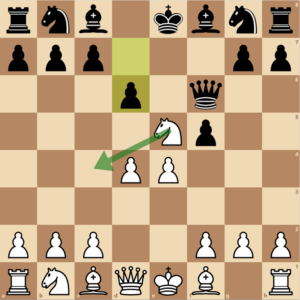The Latvian Gambit is an uncommon King’s Pawn Opening that begins 1. e4 e5 2. Nf3 f5!?
The Latvian Gambit is an uncommon King’s Pawn Opening that begins 1. e4 e5 2. Nf3 f5!?

This pawn sacrifice is an aggressive attempt from black to take control of the game, immediately putting the question to white’s e4 pawn.
In master-level chess, the Latvian Gambit has always been considered dubious – black’s pawn sacrifice is probably not entirely sound. However, it can certainly be a good surprise weapon against an unsuspecting opponent!
Let’s consider white’s options at how the game can progress:

This hasn’t been white’s most popular response to the Latvian Gambit in recent years, as black is able to immediately kick the white knight away from the f3 square.
But after 4. Ne5 (or 4. Nd4), black must address the threat of Qh5+. This weakened diagonal to the king is a big disadvantage to playing the Latvian Gambit (or any chess opening where the f-pawn is moved too early!)
After 4…Nf6, white can play 5. Be2 and once again threaten to give a check along the e8-h5 diagonal.
Want to take your chess openings BEYOND the basics? Click HERE to sign up for my FREE one-week “Opening Mastery Masterclass”

It’s surprisingly difficult for black to successfully deal with this threat! One line continues 5…d6 6. Bh5+ Ke7 7. Nf7 Qe8 8. Nxh8 Qxh5 9. Qxh5 Nxh5:

Black is down the exchange, but they are hoping that the white knight trapped on h8 can later be picked up. In practice, this has proven to be easier said than done, and white has scored quite well in this position.
Black may want to consider an alternative line such as 6…Bc5, at least giving the f8 square to the poor king, but black’s defensive task may remain difficult.

This has become white’s most popular way to play against the Latvian Gambit. Not only does white win a pawn, but white immediately threatens to play Qh5+. If black were to meet this check with …g6, then Nxg6 would win a pawn due to the pin on the h-file.
Black will occasionally play the daring 3…Nc6!?, covered in the above video, allowing white to execute the aforementioned threat! But black’s most popular remove remains 3…Qf6, attacking the knight and adding support to the g6 square to block checks along the diagonal. Then after 4. d4 d6:

White will most often retreat this knight to the somewhat unusual c4 square, so as not to allow black to play …fxe4 with tempo.
After 5. Nc4 fxe4 6. Nc3 Qg6, white does well after opening the position with 7. f3

White is no longer up material, but white’s lead in development poses black some real headaches, which will only be made worse if the center opens up.
7. Ne3 is an alternative option covered in the above video – white was winning within a few moves after black went wrong with an early …d5 !
White has a couple other ways to deal with the Latvian.
3. d3?! is playable of course, but rather passive. If white simply defends the e-pawn, black could play 3…d6, and we transpose to a rare line from the Philidor Defense.
3. d4!? is a sort of “Falkbeer CounterGambit with an extra tempo” that white could play. It’s never been too popular, because white tends to get a comfortable advantage by playing the main moves covered above, but it’s worth considering.
3. Bc4 can lead to extremely sharp play, and is covered in the video above. After 3…fxe4 4. Nxe5, black cannot adequately defend against all of white’s threats (Qh5 and Nxf7), so black counterattacks the g2 pawn with 4…Qg5. The main line ends up with black winning the h1 rook in the corner but coming under a huge attack, in true 19th-century romantic-era fashion!
I can’t recommend the Latvian Gambit as a mainstay in any player’s opening repertoire. Quirky opening lines can be great fun, but this one is a little too dubious – black’s life is quite hard if white chooses one of the main lines.
That said, the Latvian can be a great surprise weapon or an effective tool for your blitz game arsenal! And if you play the King’s Pawn Opening with white, you will need to know how to handle this pawn sacrifice so that you don’t end up surprised yourself.
Want to take your chess openings BEYOND the basics? Click HERE to sign up for my FREE one-week “Opening Mastery Masterclass”
Enter your email address to sign up for free!

